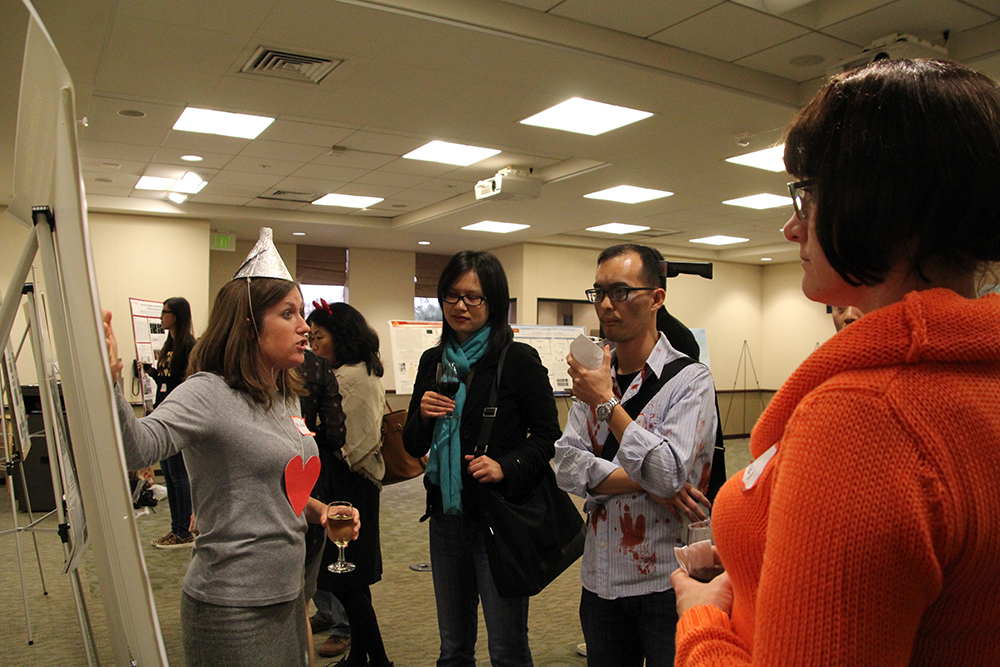
It was no tricks and all treats at the seventh annual retreat for the Eli and Edythe Broad Center for Regenerative Medicine and Stem Cell Research at USC, held at the university’s Davidson Conference Center on Halloween.
Center Director Andy McMahon welcomed nearly 100 researchers and encouraged them to mingle and get to “know at least two other people that you didn’t know by the end of the day.”
One face that was already familiar to everyone in the room was that of keynote speaker and renowned imaging pioneer Scott Fraser, Provost Professor of Biological Sciences and Biomedical Engineering and the Director of Science Initiatives at USC.
He began his talk about imaging with a mention of one image that he couldn’t get out of his mind—thanks to the black-and-white domino costumes worn by the spirited members of Gage Crump’s lab.
“Boy, it’s distracting having the dominoes in the audience,” he said. “I keep thinking about lining you up and then knocking the first one down.”
He then shared the latest advances in imaging, including a technique called Phase-variance OCT that enables doctors to quickly and painlessly detect leaky or fragile blood vessels in the eye. Doctors can then repair these tenuous vessels — common in the elderly and in diabetics—before the formation of damaging or blinding blood clots.
During another special presentation, principal investigator Michael Bonaguidi, the newest recruit to the Department of Stem Cell Biology and Regenerative Medicine, spoke about the properties of neural stem cells in the normal and injured adult brain.
For the majority of the day, the spotlight was on the USC stem cell research center’s talented PhD students, postdoctoral scholars, research associates and visiting scholars.
During an opening session focused on the theme of disease and regeneration, Kimberley Babos from Justin Ichida’s lab discussed more efficient ways to reprogram skin cells into motor neurons. The Ichida lab is currently testing FDA-approved drugs on motor neurons formed by reprogramming skin cells from patients with amyotrophic lateral sclerosis (ALS), or Lou Gehrig’s disease, in search of new treatments.
During the same session, Joanna Salva from Amy Merrill’s lab talked about how a mutation in a gene called Fibroblast Growth Factor (FGF) leads to the skeletal malformations in Bent Bone Dysplasia Syndrome (BBDS); USC medical student Marissa Srour from Francesca Mariani’s lab presented her research about mouse rib repair; and Hu Zhao from Yang Chai’s lab shared his finding that skull sutures house a special population of stem cells.
The next session explored cell signaling as it relates to various aspects of embryonic organ development, with presentations by Amjad Askary and Chong Pyo Choe from Gage Crump’s lab, Susana Cavallero and Hua Shen from Henry Sucov’s lab, Wen-Hsuan Chang from Wange Lu’s lab and Jingyuan Li from the Chai lab.
The technology session consisted of Fraser’s keynote address as well as a presentation from his postdoctoral fellow Ben Steventon, who also works in the lab of Alfonso Martinez-Arias at the University of Cambridge. Steventon introduced a new experimental system for understanding the genetics of embryonic stem cells in their natural environment.
Junfeng Jiang from the lab of Qi-Long Ying rounded out the technology session by demonstrating how a gene editing tool called CRISPR/Cas9 could generate mice with chromosomal abnormalities mimicking those involved in certain prenatal disorders and cancers. These mice could give researchers a new way to study these disorders and hopefully find new therapies.
The final session delved into genetics and “epigenetics,” or how genes are either “turned on” or “turned off,” with presentations by Xiaoying Zhou from Gregor Adams’ lab, Erin Moran from Ruchi Bajpai’s lab, Zlatka Stojanova from Neil Segil’s lab and Xinjun He and Lori O’Brien from the McMahon lab.
O’Brien then received a pleasant surprise when it was announced that she had been selected as the first of a series of Broad Fellows, exceptional senior postdoctoral researchers at the transition point to starting their own stem cell laboratories. Established as part of a $2 million gift from The Eli and Edythe Broad Foundation to USC’s stem cell research center, the fellowship will provide funds to support the launch of her independent career.
The day ended with a cocktail hour and poster session, giving researchers a chance to compliment each other on their clever research — as well as their clever costumes.
To view photos from the retreat, visit flickr.com/photos/106541334@N04/sets/72157646794449363.
